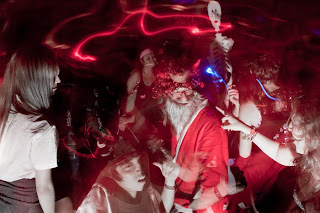It got very cold in Iwaki a few days ago – colder than I thought it would get, or at least quicker than I expected. This cold is not something that I am used to. I can’t tell if it’s because I wasn’t prepared for it, or if it is because this cold is a different one than what I’m used to.

I can’t see my breath, and there is very little wind – the sun is even still out much of the time. Maybe it’s because I don’t have the proper clothes. Somehow, the cold goes deep and from the advice of someone who’s been through it all, I prepared to never be fully warm again for the coming months.
Part of the reason that I am so cold can be attributed to the Japanese attentiveness to heating – or lack thereof. Few apartments/buildings have central heating. Instead, they rely on individual heating units. In my apartment, there are three forms of heat. One is an electric base heater that plugs into the wall. It was 3 settings: top element, bottom element, and both elements. It doesn’t have a fan, so the heat has no way of circulating and it is my understanding that electric heat is expensive to run. I use it in the morning or at night when I want to add a quick burst of heat to a particular area that I know I will be for a while.
I also have an air-conditioning unit, which conditions the air to be warm as well as cold. This unit has various temperature control settings and also features a fan that distributes the air in the room. It also has a timer – although I haven’t figured it out how to use it yet. Unfortunately, this unit is also located near the ceiling of my apartment and the heat doesn’t always reach the floor. I often find myself feeling cold sitting on the couch only to stand up into the warm half of the room. It is also electric and can be costly if used too much.
Finally, I have a kerosene heater. This, by far, seems to be the most effective and cost effective means for heating my apartment. Unfortunately, after firing it up for a few minutes last night, I learned that the fumes it emits are not pleasant. I am not sure if this is something that merely needs getting used to. Many people in Japan use kerosene heating and after reading a few websites, it seems to be safe as long as the window is open a small amount. It is recommended that the unit not be left on unattended – i.e. when sleeping. There was only one teacher who I talked to today who said that she wouldn’t use kerosene because the fumes gave her a headache; but she said that she often forgot, or neglected to open a window.
At school, I also have an air conditioning/heating unit in my office, but will not be activated until December 1st. Apparently, this is the day when it officially gets cold every year. When the teacher who I share the office with stepped into the room and saw me huddled at my desk with three shirts, two jackets, a scarf, hood on, and some fabric I found in the Halloween decorations box draped over my legs, he suggested that this room, because it does not receive any direct sunlight, and is only ever occupied by one-two people, is probably the coldest room in the building.
It is supposed to warm up a bit in the next few days, but still, I was lucky enough to have a teacher take me to the furniture store tonight. Because I still only had a summer futon and blanket, I slept with a wool sweater on – as well as a small blanket and a tablecloth over me last night. Tonight, I look forward to stacking a second, proper winter futon on top of my old one, and sleeping under a second comforter. I also have slippers awaiting me in the morning, which I will try, but cannot guarantee that they will be placed in the proper, side-by-side, toes and heels together fashion that seems the custom in this country.
On another side-note, last week, a student who frequents my office quite a bit asked me if I would show him how to play chess. In return, he would show me how to play the Japanese version, shogi. We met today after school and he arrived with his chessboard that he got sometime in his early childhood. I began by asking him if he knew how to set the board up and how each piece could move. He said he did and so we began playing. Within four moves, it was apparent to me that I was going to lose this game. I’m not sure what he originally meant when he said, “teach him how to play,” but he gave me a bit to think about for our next game on Friday.











































